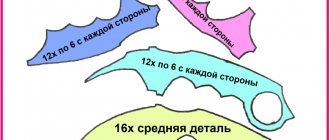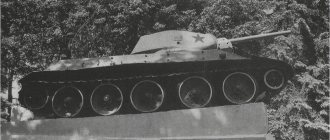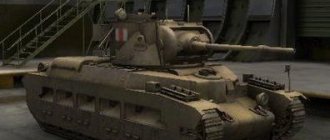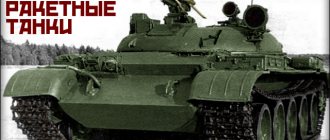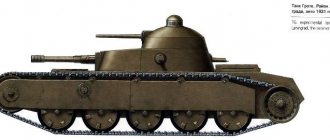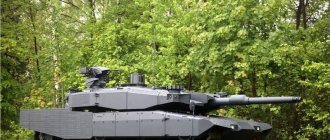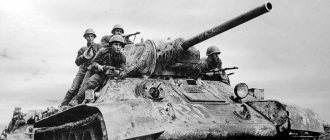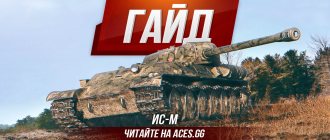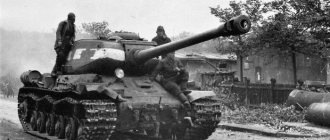| IS-4 | |
| Classification: | Heavy tank |
| Combat weight, t: | 60 |
| Layout diagram: | Classical |
| Crew, persons: | 4 |
| Story | |
| Developer: | GSKB-2 |
| Manufacturer: | USSR |
| Years of development: | From 1943 to 1946 |
| Years of production: | From 1947 to 1951 |
| Years of operation: | From 1947 to early 1960s |
| Number of issued, pcs.: | 258 |
| Main operators: | USSR |
| Dimensions | |
| Case length, mm: | 6600 |
| Length with gun forward, mm: | 9790 |
| Case width, mm: | 3260 |
| Height, mm: | 2480 |
| Base, mm: | 4385 |
| Track, mm: | 2500 |
| Ground clearance, mm: | 410 |
| Booking | |
| Armor type: | Rolled and cast steel |
| Body forehead (top), mm/deg.: | 140/61° |
| Body forehead (middle), mm/deg.: | 140/61° |
| Body forehead (bottom), mm/deg.: | 160/40° |
| Hull side (top), mm/deg.: | 160/30° |
| Hull side (bottom), mm/deg.: | 160/0° |
| Hull stern (top), mm/deg.: | 100/38° |
| Hull stern (middle), mm/deg.: | 100/32°..30/85° |
| Hull rear (bottom), mm/deg.: | 100/39° |
| Bottom, mm: | 30 |
| Housing roof, mm: | 30 |
| Turret front, mm/deg.: | 250 |
| Tower side, mm/deg.: | 200/35° |
| Tower feed, mm/deg.: | 170 |
| Tower roof, mm: | 30 |
| Armament | |
| Caliber and brand of gun: | 122 mm D-25T |
| Gun type: | Rifled gun |
| Barrel length, calibers: | 48 |
| Gun ammunition: | 30 |
| Firing range, km: | Up to 5 |
| Sights: | TSh-45, K-8T, |
| Machine guns: | 2 × 12.7 mm DShKM |
| Mobility | |
| Engine's type: | AT 12 |
| Engine power, l. With: | 750 |
| Highway speed, km/h: | 41..43 |
| Speed over rough terrain, km/h: | 15..20 |
| Cruising range on the highway, km: | 170 |
| Cruising range over rough terrain, km: | 80..140 |
| Specific power, l. s./t: | 12,4 |
| Suspension type: | Individual torsion bar |
| Specific ground pressure, kg/cm²: | 0,9 |
| Climbability: | 35 |
| Wall to be overcome, m: | 0,9 |
| Ditch to be overcome, m: | 2,8 |
| Fordability, m: | 1,5 |
IS-4 (GBTU Index - Object 701 ) is a Soviet heavy tank of the post-war period, adopted for service in 1947.
History of creation and production
In July 1943, SKB-2 of the Chelyabinsk Kirov Plant (ChKZ), headed by the newly appointed chief designer N.L. Dukhov , on his own initiative, began developing a new heavy breakthrough tank, significantly superior in basic combat properties to the German heavy tanks TV "Panther" and T-VI "Tiger". The main goal in creating a vehicle codenamed “heavy tank K ” was to provide reliable protection for the tank from shells from modern foreign tank guns at an effective firing range. The work manager was I.M. Zaltsman, who at that time was the director of ChKZ, the leading designer and engineer of the project - L.S. Troyanov (later Dukhov’s deputy, M.F. Balzhi, was appointed project manager). The development of systems, components and assemblies was led by the following designers: Myakishev (body), Shukhman (power plant), Kruchenykh (weapons), Sergeev (transmission), Goldstein (electrical and radio equipment), Voloshin (spare parts).
In SKB-2, the preliminary design of the K tank was approved on December 10, 1943 . It was decided to leave its layout the same as that of the IS-122 . Strengthening armor protection was achieved by increasing the thickness of the tank's hull and turret armor. When designing the original design of the tank hull, hull designers B.N. distinguished themselves. Yakovlev and G.A. Klemec. Due to the increased weight of the tank, a seven-support (applied to one side) chassis design was used, and the track was expanded to 730 mm. A new design of the shoulder strap, which absorbs radial and axial loads with one row of balls, without the use of so-called grippers, was proposed by S.V. Fedorenko. The radiators were blown by two horizontal axial fans, like those of German heavy tanks.
An increase in the tank's combat weight required an increase in engine power. By this time, SKB-75 (chief designer for engine building of ChKZ and the special design bureau - I.Ya. Trashutin) had created a four-stroke twelve-cylinder V-shaped diesel engine V-12, which was boosted to 552 kW (750 hp, at 2100 rpm) version of the V-2 diesel engine by introducing a drive centrifugal supercharger (PNC) and increasing the fuel supply. In addition to the use of a drive supercharger, the V-12 diesel engine differed from previously produced engines in some changes in the design of the pistons, crankshaft, crankcase, cylinder head, injectors, camshaft, exhaust valves, oil filter, fuel and water pumps, aimed at increasing the reliability of these nodes The V-12 became the first supercharged V-2 engine from PNTs.
In the process of modernizing the IS-122 , the result of which (together with plant No. 100) was the “Object 703” , work on the “Object 701” (this designation was given to the “K” tank) was temporarily frozen, but then resumed. The construction of the Object 701 tank was financed from the factory budget and was carried out on an area fenced off from prying eyes by high metal partitions. Here the process of manufacturing a tank corps, installation of chassis components, engine-transmission and fighting compartments was underway. The vehicle received a new 122-mm rifled gun D-25T KB F.F. Petrov , prototype No. 3A of the V-12 engine and a new type of transmission.
Back in 1935-1936, scientists M.I. Christie, G.I. Zaichik and M.A. Kreines proposed a scheme for a new rotation mechanism (MP) based on asymmetrical differentials, which was later named in honor of the authors “group of mechanisms of the Zaichik-Kreines type”, or “ZK”. This mechanism, which had no analogues in the world, was made of metal and was tested on the T-38 light amphibious tank, but due to the great complexity of the design and the limited technological and production capabilities of that time, it did not receive practical use. Its main advantages were: automatic increase in torque on the drive wheels when turning compared to straight movement; stable straight-line movement in any conditions; creating braking force without the use of brakes.
The transmission used on “Object 701” was designed and manufactured in 1943-1944 by the joint efforts of ChKZ (L.B. Tevelev) and Moscow Higher Technical School named after N.E. Bauman. The designers tried to increase the mobility of a heavy tank by using the most economical among other known types of MP - the planetary MP of the "ZK" type, which automatically increased the traction forces when turning both from the side of the advancing and from the side of the lagging side. For the “Object 701” with a low specific power of 9.2 kW (12.5 hp/t), this turning mechanism reduced the power required for turning, since the braking force was generated by turning off the locking clutch without the participation of the brakes, and therefore No engine power was wasted on friction in the brakes. (In 1945, “for the development of the design of new tank control mechanisms,” the Stalin Prize of the 2nd degree was awarded to the MVTU research workers: G.I. Zaichik, M.K. Christie, K.G. Levin and M.A. Kreines.)
Armor parts with a thickness of 120-160 mm were made of 42SM steel and processed to medium hardness. The cast turret made of 66L steel was also processed to medium hardness, the remaining parts made of 8C steel were hardened to high hardness. In the design of the hull, “tenon” and “quarter” connections with relief pins were widely used. Unlike the IS-122, all of whose seams were butted or overlapped, in the Object 701, due to the use of more complex ones and the installation of additional gussets, the main welds were unloaded and worked not for shear, but for compression and had high strength. Welding of armor parts was carried out manually using a multilayer back-step weld using austinitic and carbon electrodes of grade 55-U.
In March 1944, the technical project of “Object 701” was submitted to the commission of the Technical Directorate of the GBTU, which came to the conclusion that “in terms of its main combat qualities, weapons, armor, components and assemblies of the power plant and transmission, tank and fire control mechanisms, the tank design The Kirov Plant certainly deserves to give the Kirov Plant permission to produce two prototypes as soon as possible... There is every reason to obtain the best heavy tank in the world that meets modern combat requirements.”
By this time, in accordance with GKO Decree No. 4851ss of December 27, 1943 “On the design, manufacture and testing of prototypes of artillery guns for tanks and self-propelled artillery units,” a 100-mm S-34 tank gun with a barrel length of 56 calibers and ballistics was designed naval gun B-34. At the same time, at its base it was planned to install a 122-mm barrel with a length of 47 calibers and the ballistics of a 122-mm A-19 hull gun. This gun was named C-34-II. As a result of the joint work of the designers of TsAKB and ChKZ, a new fighting compartment of the Object 701 tank was designed with the loader located on the left side of the gun.
Based on the GKO decree No. 5583ss of April 8, 1944 “On the production of prototypes of a new heavy tank at the Kirov NKTP plant,” the NKTP was allowed in April to produce at ChKZ two prototypes of the heavy tank “Object 701” with guns designed by TsAKB and one hull and together with the GBTU to test the tanks and shell the hull.
The first prototype of the “Object 701” tank, retroactively designated “Object 701” No. 0 (this tank was not supposed to be presented for acceptance tests, since it did not meet the TTT) was manufactured by the end of April 1944. As a result of lengthy factory tests that took place until June 15, 1944, the prototype vehicle covered 1,230 km, and a number of shortcomings in its design were identified.
At the same time, in May - June 1944, according to the decree of the State Defense Committee, the plant produced the Object 701 tank No. 1 with a 122 mm S-34-II cannon and the Object 701 tank No. 2, equipped with a 100 mm S-34-I cannon . The thickness of the armor of the front and side plates of the turret and hull was the same and did not exceed 160 mm. Both tanks were presented for field testing to the GBTU commission chaired by its chief, Lieutenant General of Tank Forces B.G. Vershinin, which took place in the Chelyabinsk region from July 1 to August 15, 1944.
During testing on July 13, the final drives on machine No. 1 failed, and its testing was stopped (in addition, a defect was discovered - the transmission “drove”). The average speed of the tank during testing was 21 km/h, the total mileage was 1103 km. On the second car, the transmission worked satisfactorily, but an increased thermal condition of the engine was recorded. The average speed of the Object 701 tank No. 2 was 24 km/h, fuel consumption was 97...102 liters per 100 km, mileage was 492 km.
In a detailed report presented on July 30, 1944, the GBTU commission highly appreciated what they saw: “The experimental tank 701, in its main combat qualities, is the most modern heavy tank, superior in armor to all existing domestic tanks, and enemy tanks, in addition, in armament and maneuverability . Increased combat qualities were achieved: by the use of 160 mm thick armor plates, a well-designed hull and turret, the installation of a V-12 diesel engine with a power of 750 hp, and the installation of an original planetary transmission with a selector control mechanism.” At the same time, unreliable operation of the final drives and planetary transmission was noted. The driver's viewing devices did not provide good visibility, dismantling the transmission roof was difficult, and the chassis needed to be strengthened with support and support roller disks.
Meanwhile, the turrets of the repaired tank “Object 701” No. 0 and vehicle No. 1 were swapped. Thus, to test the S-34-II gun, “Object 701” No. 0 with a turret from the “Object 701” No. 1 tank was sent to Gorokhovetsky ANIOP. Field tests of the S-34-II, carried out under the Artkom GAU KA program in the amount of 780 rounds (of which 440 were reinforced), were completed on October 2, 1944. The S-34-II gun had a number of undoubted advantages over the D-25T. Its design was more rigid and therefore the accuracy of fire during testing turned out to be higher than that of the D-25T. The absence of a muzzle brake reduced the unmasking effect when firing, and also reduced the risk of hitting own infantry and tank landing forces with muzzle gases.
Vehicle No. 2 and the armored hull “Object 701” No. 3 were sent for testing by anti-tank artillery fire at the Research Armored Test Site (NIBT) located in Kubinka. An interesting fact is that the presented options differed in the thickness and angle of inclination of the turret part of the hull: 160 mm/30° and 120 mm/50°, respectively. During tests carried out from August 5 to August 25, 1944, the tanks were fired from both domestic guns, such as the 57-mm ZIS-2 with an initial projectile speed of 1270 m/s, the 76-mm ZIS-3 - 910 m/s, 122 mm D-25 - 800 m/s and 152 mm ML-20 - 600 m/s, as well as from the German, captured 88 mm PaK 43 anti-tank gun and 75 mm KwK 42 tank gun.
The test results showed high strength of the welded joints of the hull. The commission's findings noted:
| “The armor of the “object 701” tank provides complete protection against 75- and 88-mm armor-piercing shells with an initial projectile speed of 1000 m/s from all distances during directional fire up to ±60° along the hull and ±30° along the turret... Option No. 2 has better protection against armor-piercing projectiles, but weaker than No. 3 when exposed to sub-caliber projectiles. Taking into account the decrease in the use of sub-caliber projectiles, a proposal was made to adopt hull version No. 2, since it is 400 kg lighter... Thus, with a relatively small increase in weight, the 701 object is superior in armor resistance to the IS-2 tank in service, the hull and turret of which penetrate at any heading angles with an 88 mm armor-piercing projectile from a distance of 2000 to 800 meters.” |
The shortcomings indicated by the commission included insufficient protection of the hull from 75- and 88-mm armor-piercing shells when fired at the hull at heading angles of 60° - 90° and the turret at angles of more than ±30°, weak armor protection of the commander's cupola compared to the sides of the turret, as well as a decrease in the armor resistance of the turret due to the tide under the TSh-17 sight.
In its conclusion, the commission recommended adopting the hull and turret of the Object 701 tank No. 2 with changes made according to the commission’s comments. In addition, the question was raised about developing a variant and manufacturing a turret from rolled armor steel with a thickness of 180-200 mm, as well as increasing the thickness of the top sheet of the hull to 140-160 mm and the zygomatic bevels (structural angles) to 140 mm to provide protection from promising 105 - and 128 mm enemy guns.
Based on the results of the tests and the conclusion of the commission that conducted the sea trials, NKTP order No. 500 of August 11, 1944 was issued, in which the People's Commissar of the Tank Industry of the USSR V.A. Malyshev demanded from I.M. Zaltsman and N.L. Dukhov to take into account and eliminate the defects identified during testing, by October 1, 1944, present two new tank models to the State Commission for repeated field tests and issued a reminder:
| “Planetary transmissions for heavy tanks are insufficiently studied in operation and mastered in production and require particularly careful inspection and more stringent testing to ensure reliability and trouble-free operation in the tank.” |
In the report of the Deputy Commander of the armored and mechanized forces of the Red Army P.A. Ro of August 30, 1944 noted:
| “A design defect of our tanks is the obsolescence of a number of important units, namely: the turret rotation mechanism, the gearbox on the IS... The armor of a heavy tank, and especially the shape of its hull, does not meet the requirements for the armor of vehicles of this class... Instead of the existing heavy tank it is necessary speed up the commissioning of the 701 tank... The 701 tank is currently the best heavy tank in the world tank fleet. With a streamlined hull similar to the T-34, up to 180 mm of armor, a 122 mm gun, and a modern transmission that will give it high maneuverability, this tank will truly be unbeatable on the battlefield...” |
A total of 258 tanks were produced during serial production. They were mainly sent to military units in the Far East. During operation, it turned out that the mass of the tank exceeded the carrying capacity of most bridges and vehicles. In addition, many shortcomings and comments were revealed, including insufficient reliability of individual transmission components. The service of the new tank was short-lived - the IS-4 was taken out of service and put into long-term storage, and then removed from service.
Prototypes
Before being put into service, several prototypes of the tank were created, one vol. 701-2 with a 100 mm S-34 cannon and 160 mm turret frontal armor (weight 55.9 tons). Other samples vol. 701-5 and 701-6 are armed with a 122 mm D-25 cannon (weight 58.5 tons).
Foreign analogues of the IS-4
The IS-4 began to be mass-produced after the end of World War II, and at that time there were no analogues of the tank in service in other armed forces. Purely hypothetically, one can compare the IS-4 with the armored vehicles produced by the armies of Germany and the United States during the war. Noteworthy is the protection of the Soviet tank, which is noticeably superior to that of the “Royal Tiger”, but at the same time the weight is 10 tons lower.
| IS-4 | Pz.Kpfw. VI Ausf. B "Tiger II" | T1E1 | |
| Weight, t | 60 | 70 | 57,5 |
| Length | 6600 | 7380 | 7544 |
| Width | 3260 | 3755 | 3124 |
| Height | 2480 | 3090 | 2997 |
| Clearance | 410 | 495 | 520 |
| Power, l/s | 750 | 700 | 700 |
| Maximum speed, km/h | 43 | 41,5 | 32 |
| Armor protection of the hull (forehead, sides, rear), mm | 140(top)-160(top)-160-100 | 150-80-80 | 127-78(top)-67(bottom)-51 |
| Armor protection of the turret (front, sides, rear), mm | 250-200-170 | 185-80-80 (Henschel tower) | 83-83-83 |
| Armament | 122 mm D-25T, 2 machine guns | 88 mm KwK 43 L/71, 3 machine guns | 76.2 mm M7, 37 mm M6.4 machine guns |
| Initial projectile speed, m/s | 800 | 1000 | 972 |
In terms of tactical and technical characteristics, the IS-4 had almost identical parameters to the German vehicle, but was somewhat inferior in gun power. Also, we should not forget that the German analogue was equipped with a carburetor engine, which worked at the limit of its capabilities. And the American analogue T1E1 (manufactured during the Second World War, but never took part in hostilities) was superior in all respects.
Mass production
In 1946, the IS-4 tank was officially adopted by the Soviet army. In the same year, the Chelyabinsk Tractor Plant was ordered to stop producing IS-3 tanks and begin producing the IS-4 tank. According to plans, 155 IS-4 tanks were to be produced in 1946. However, the work was not completed; in 1946, the production amounted to only 6 tanks of the pilot batch. The reasons for the delay were a number of R&D aimed at eliminating the defects identified during tank testing, as well as ChTZ’s transition to peaceful post-war construction and a sharp increase in the production volume of tractors for national economic needs. Due to missed deadlines, plans for the production of the IS-4 were adjusted and provided for the production of 200 units in 1947. In 1947, tanks from the 1946 batch were again sent for testing. After testing, appropriate changes were made to the design to eliminate the comments. 30% of the tank's components and assemblies required changes, so instead of the planned 200 units, only 52 IS-4 tanks were produced in 1947.
In 1948, IS-4 tanks were again sent for testing, where significant defects were again discovered. To eliminate the defects, an action plan was developed to improve the design of the vehicle, but the plan was not implemented and the production of IS-4 tanks continued with significant defects. The main cause of the defects was poor manufacturing quality, during which technological processes were disrupted, and there were also significant deviations from the design documentation. 50-60% of produced tanks were rejected by the manufacturer due to military acceptance. In 1949, by order of Marshal of the Armored Forces S.I. Bogdanov's acceptance of IS-4 tanks was stopped until measures were developed to improve manufacturing quality. By August 1949, 12 tanks were manufactured and tested again. However, improvements based on the test results were carried out with significant delays, since the entire GSKB-2 team was switched to the development of the new heavy tank “Object 730”, as well as the light tank “Object 740”. As a result, plans to modernize previously delivered vehicles, as well as to manufacture an improved version of the IS-4, were not implemented. In 1951, a small batch of improved IS-4M tanks was produced, and all previously produced vehicles were modified to the IS-4M level, after which serial production of the IS-4 was completed.
| Release schedule of the IS-4 tank and its modifications | |||||||||
| 1944 | 1945 | 1946 | 1947 | 1948 | 1949 | 1950 | 1951 | Total | |
| IS-4 | 6 | 2 | 6 | 52 | 155 | 12 | — | — | 233 |
| IS-4M | — | — | — | — | — | — | — | 25 | 25 |
| Total | 6 | 2 | 6 | 52 | 155 | 12 | — | 25 | 258 |
Design description[edit]
Hull and armor[edit]
Scheme of tank armor protection.
The IS-4 was developed on the basis of the IS-2 heavy tank and had a welded hull of increased rigidity and a cast turret with variable wall thickness.
The tank hull was assembled by welding from cast sections and rolled armor plates with a thickness of 20, 30, 120 and 160 mm. The front part of the hull consisted of upper and lower frontal, and two side armor plates, installed at large angles of inclination. Along the axis of the car there was a place for the driver, above whose seat there was a small round hatch with an inspection device, with a lid that opened to the side. A log for self-pulling was attached to the right side of the hull. Two cylindrical 90-liter fuel tanks were installed on each rear wing. They are not connected to the fuel system, so the fuel was simply pumped into the internal tanks. In the center of the stern of the hull there are places for installing MDSh (Naval Smoke Bomb) smoke bombs. In the stern there is a mechanism for attaching the gun in the stowed position. There are two tool boxes on the left side.
The tank's turret was assembled from several cast parts; its front part was covered with a removable armor plate fastened with bolts. The hatch, closed by this sheet, was intended for mounting and dismantling the gun. At the rear of the turret roof there was a tank commander's hatch with a lid on the left, and a loader's hatch with a lid on the right. There were viewing devices in the hatch covers and the left side of the roof, and in the commander’s hatch cover there was a TPK-1 periscope viewing device. The rotation of the tower, with the planetary unit of the rotation mechanism, was carried out both using an electric drive and manually, and both drives were allowed to operate simultaneously.
| IS-4 armor[2] | |
| Armor type | rolled and cast steel |
| Body forehead (top) | 140 mm / 61° |
| Body forehead (middle) | 140 mm / 61° |
| Body forehead (bottom) | 160 mm / 40° |
| Hull side (top) | 160 mm / 30° |
| Hull side (bottom) | 160 mm / 0° |
| Hull stern (top) | 100 mm / 38° |
| Hull stern (middle) | 100 mm / 32° – 30 mm / 85° |
| Hull stern (bottom) | 100 mm / 39° |
| Bottom | 30 mm |
| Housing roof | 30 mm |
| Tower forehead | 250 mm |
| Tower side | 200 mm / 35° |
| Tower stern | 170 mm |
| Tower roof | 30 mm |
Weapons[edit]
The armament of the serial IS-4 was slightly strengthened compared to the IS-2 and IS-3. The turret was equipped with a twin installation of a 122-mm D-25T cannon and a 12.7-mm DShK machine gun. On the anti-aircraft turret there was another DShK with a K-8T collimator sight. For direct fire from a gun, a telescopic articulated sight TSh-45 was used; from closed positions, shooting was carried out using a side level and a goniometric circle on the turret chase.
An ammunition load of 30 separately loaded shells was placed in special metal cassettes consisting of a cylinder, a shock-absorbing spring and a spring lock. In cassettes for armor-piercing projectiles, an additional cup was inserted (between the shock-absorbing spring and the head of the projectile), and in cassettes for high-explosive fragmentation - a fuse cap for the head fuse. There were 12 cassettes for armor-piercing tracer shells, and 18 for high-explosive fragmentation grenades. Cartridges for 12.7 mm machine guns were placed in two stacks of 500 pieces each. In one installation, cartridges were loaded into belts of 50 pieces each and placed in box magazines, two of which were on machine guns. In the second installation, cartridges in packs of factory packaging were stored in four canvas bags.
Tanks produced in 1947-1948 were equipped with modernized DShKM machine guns of the 1938/46 model, a K10-T collimator sight and YURT radio stations.
Engine and transmission[edit]
Radiator fan.
The tank's power plant consisted of a 12-cylinder 4-stroke V-shaped uncompressor V-12 liquid-cooled engine with a power of 750 hp. (552 kW) at 2100 rpm with 2-stage Multicyclone air cleaners. The engine produced by Chelyabinsk Tractor Object 701 did not fully meet the original technical requirements. Therefore, they decided to use the “zero” tank as a platform for testing new ideas, but not consider it an experimental vehicle of the “701” project.
Modifications[edit]
- IS-4K - “Commander”. The tank is equipped with an additional radio station.
- IS-4M – “Modernized”. Changes were made to the chassis, which allowed for slightly improved mobility. Other changes are minor.
Machine evaluation
During operation, it turned out that the mass of the tank exceeded the carrying capacity of most bridges and vehicles. In addition, insufficient reliability of individual transmission components was revealed. After the release of a small series it was discontinued. In 1956, all tanks underwent a major overhaul at the Darnitsa Tank Repair Plant and were put into storage at the base in Osipovichi. In 1970, in Osipovichi, on their basis, 20 separate military units were created, consisting of 10 tanks, a ZIL-130 truck, an artillery crew for firing with PDO, cooks, and sent to fortified areas along the entire Soviet-Chinese border. At the end of the 1970s, all tanks were sent for melting down.
Operation[edit]
Due to the low reliability of the transmission, low cross-country ability and maneuverability, the operation of IS-4 tanks in military units was short-lived and irregular. At the end of 1947, 4 tanks entered the Chelyabinsk Tank Technical School and another 4 units entered the 30th Training Tank Regiment (Chelyabinsk). The remaining 1947 vehicles and most of the 1948 vehicles were stored at the 22nd Reserve Base.
A small number of IS-4s entered service with the heavy self-propelled tank regiments of the 5th Guards Mechanized Army of the Belarusian Military District, where they remained until the early 1960s, and then were sent to Transbaikalia and Primorye, where they were placed in long-term storage. They were supposed to be used as long-term firing points in fortified areas in the event of a military conflict on the border with the PRC.
Surviving copies
Due to the short production time of the tank, only a few surviving copies are known:
- Russia: Armored Museum in Kubinka (Moscow region) - on display at the museum
- Chita - in the exposition of the Park of the House of Officers of the Russian Army
- Zabaikalsk - monument
Content
- 1 History of creation
- 2 Design description 2.1 Hull and armor
- 2.2 Armament
- 2.3 Engine and transmission
- 2.4 Chassis
- 2.5 Electrical equipment
- 3.1 Prototypes
- 7.1 Video games
Gallery[edit]
- Is-4 being tested.
- A bridge that collapsed under the weight of the IS-4.
- Rear view of the IS-4. Noteworthy is the location of the additional fuel tanks, which is characteristic and unusual for Soviet tanks.
- Top view of the turret and rear hull of the IS-4 tank. The exhaust pipes and fan plates are clearly visible.
- The only complete IS-4 tank is on display at the Military Historical Museum of Armored Weapons and Equipment in Kubinka.
- Projections.
- Combat compartment.
- IS-4 at the Armored Museum in Kubinka.
- IS-4 with the M62-T2 gun in the game “world of Tanks”.
- Tank layout using the example of the game "War Thunder".
Literature
- M. Baryatinsky, M. Kolomiets, A. Koshchavtsev. Soviet heavy post-war tanks
. - M.: Bronekollektsiya, issue No. 3, 1996. - M. Baryatinsky. Soviet armored vehicles 1945—1995
. - M.: Armored collection, issue No. 3, 2000. - Karpenko A. V., Review of domestic armored vehicles (1905-1995)
, St. Petersburg, Nevsky Bastion, 1996. - M. V. Pavlov, I. V. Pavlov.
Domestic armored vehicles 1945-1965. // Equipment and weapons: yesterday, today, tomorrow. - Moscow: Tekhinform, 2009. - No. 8. - P. 56. - M. V. Pavlov, I. V. Pavlov.
Domestic armored vehicles 1945-1965. // Equipment and weapons: yesterday, today, tomorrow. - Moscow: Tekhinform, 2012. - No. 11. - P. 54. - M. V. Pavlov, I. V. Pavlov.
Domestic armored vehicles 1945-1965. // Equipment and weapons: yesterday, today, tomorrow. - Moscow: Tekhinform, 2012. - No. 12. - P. 51-56. - IS-4. Heavy tank. Management.
What's in the game?
In the game we get a high-quality tank of the 10th level, a worthy competitor to the already existing company TT10, quite capable of winning back a good part of user sympathy from them.
What's good about him? First of all, it is worth noting that the tank is perfectly balanced - with reasonable play, it has virtually no serious drawbacks, namely: despite the fact that the IS-4 is the crown of the Soviet branch of TT of a defensive nature (characterized by a larger amount of HP and thicker armor), the tank cannot be called a complete slow-moving vehicle, because it has quite sufficient speed and looks pretty decent compared to its classmates. In addition, the new weapon will be to the liking of those who previously blamed Soviet tanks for their “obliquity” and long-suffering alignment - now even owners of top German equipment will be jealous of your 122-mm combat friend M-62. And one of the highest rates of fire and penetration at the level only pleasantly complements its already serious advantages.
By the way, it is recommended to study the IS-4 top gun IMMEDIATELY for FREE experience, since being the top gun in every battle with a stock gun, you automatically substitute the team and almost predetermine the outcome of the battle not in your favor. Another strong argument in favor of the IS-4 is its practicality and playability. Having the amount of HP similar to the amount of HP of the E-100 (!!!), the IS-4 has a much more penetrating gun, speed (that is, it will be able to reach places where the E-100 cannot), ricocheting and the so-called “eternally hungry sides” ", from time to time loving to eat sometimes all the damage done. In other words, the tank is capable of realizing itself on almost any map, having good makings for playing both in open areas - speed, maneuverability so as not to get hit by a suitcase and a relative rate of fire, and on urban maps - solid all-round armor, excellent penetration.
Perhaps the only drawback of the tank is its relatively weak frontal armor. However, structurally and historically this is a justified feature, and even the TT10 should have at least some drawbacks, and also fit into the overall balance. After all, WoT is first and foremost an arcade game, where everyone should have their chance
Another thing is that the enviable set of advantages of a tank unconsciously relaxes the player, sometimes depriving him of caution and calculation. And the frontal armor, penetrated at special points even by the Tiger, is often regarded by players as a flaw of the developers, rather than a feature of the tank that reminds players of attentiveness and caution
Crew:
- Crew commander (radio operator);
- Gunner;
- Driver mechanic;
- Charging.
Learning additional skills for the crew:
Standard crew:
| 1 | 2 | 3 | 4 |
For the first slot, we teach all crew members, except the commander, the “Repair” skill, and for the commander the “Sixth Sense” skill - the “Repair” skill speeds up the repair of damaged modules, and the “Sixth Sense” will allow you to determine whether his tank has been detected by the enemy. Also, all crew members need to learn the additional skill “Combat Brotherhood”, which will improve the level of proficiency in the specialty - be sure to learn it all at once, preferably used in the second or third slot.
- For the commander, we learn the “Eagle Eye” skill, which increases the viewing range.
- For the gunner, we learn the “Smooth turret rotation” skill, which reduces the spread when turning the turret; and the “Sniper” skill, which increases the chances of causing damage to modules and crew members.
- For the driver mechanic, we learn the “Smooth Move” skill, which reduces the dispersion of the weapon in motion; and the “Off-Road King” skill, which reduces resistance on soft and medium soils when driving.
- For the infector, we learn the “Non-contact ammo rack” skill, which increases the strength of the ammo rack; the “Desperate” skill, which reduces the reload time when less than 10% strength remains.
